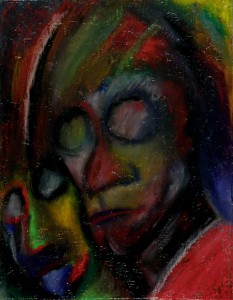Fannin and Felicia: Wasn’t Art Enough Passion?
 Art Department Chair Fannin Richardson came out of my 1990’s desire to use my visual talents to move ahead with an art life. I’d just gone through the discouraging setback of mailing off scores of query letters for my novels Sortmind and Property (the latter much improved and published 2015 as CommWealth). This was pre-Internet, when contact with publishers and agents was mailed query letters and mailed manuscripts, including self-addressed stamped envelopes for the likely return. Along the way I had the oddly uplifting experience, which I predict will never happen again, of mailing an entire 320-page typewritten MS. in a box for $10 along with $10 return postage, which the agent or slush pile reader would then eagerly affix onto that same box in order to mail it back with a slip of paper stating: “Sorry, not a fit for us.” After one hundred percent of my attempts met with rejection slips I was definitely disheartened, but I also noted something funny: rejections from book publishers were inevitably more cordial, sometimes with encouraging handwritten notes, than my stories’ magazine rejection slips, which were often snotty and hostile. Though I’d come to the conclusion that sending off these query letters was like buying a lottery ticket with a similar chance of success, at least the rejections confirmed that I was on the right path. I was a writer of novels, not of stories.
Art Department Chair Fannin Richardson came out of my 1990’s desire to use my visual talents to move ahead with an art life. I’d just gone through the discouraging setback of mailing off scores of query letters for my novels Sortmind and Property (the latter much improved and published 2015 as CommWealth). This was pre-Internet, when contact with publishers and agents was mailed query letters and mailed manuscripts, including self-addressed stamped envelopes for the likely return. Along the way I had the oddly uplifting experience, which I predict will never happen again, of mailing an entire 320-page typewritten MS. in a box for $10 along with $10 return postage, which the agent or slush pile reader would then eagerly affix onto that same box in order to mail it back with a slip of paper stating: “Sorry, not a fit for us.” After one hundred percent of my attempts met with rejection slips I was definitely disheartened, but I also noted something funny: rejections from book publishers were inevitably more cordial, sometimes with encouraging handwritten notes, than my stories’ magazine rejection slips, which were often snotty and hostile. Though I’d come to the conclusion that sending off these query letters was like buying a lottery ticket with a similar chance of success, at least the rejections confirmed that I was on the right path. I was a writer of novels, not of stories.
But the question became: who has the time or inclination to sift through your query letter, much less three sample chapters, much less your three hundred-page novel? Whereas it was obvious that people were responding in an instant to my paintings. Their effect hits you all at once and you either love the image or not, want to purchase it or not. If your book is published after five years of work and three years of query letters, you might see a teeny advance: $1,000? $1,500? Contributor’s copies? But you could easily sell five paintings, a couple weeks effort, for $400 apiece.
Pursuing the visual wasn’t primarily because I thought it would be more lucrative, but more for involvement with the world: response, feedback, growth, breaking out of the depressing state of isolation and obscurity. Visual art seemed a much more straightforward path. Except that I forgot my ancient 80/20 balance, where I feel most psychically correct when spending 80% of my time on my real love, writing, and 20% on painting and drawing. In the ’90’s I even thought of getting a masters degree to teach art in a junior college. Armed with a new garage art studio and enough extra cash to buy those terribly expensive art supplies, I turned out a couple hundred paintings, learned a lot, had some one-man shows, and sold a few works. But I also met so many people who loved “the art life” but really had little to give either as artists or gallery owners. My new visual art life provided contact with some very expensive mediocrity, lots of clever design, admittedly with some stunning jewels mixed here and there, all supervised by art gatekeepers the way the publishing industry has its literary gatekeepers.
Later, a four-month retirement and the disastrous Summer Art Career of 2006, during which I tramped in growing dismay and revulsion to numerous Dallas galleries–see a chapter title in my novel Ocean Singe Horror, “Snooty Art with Sexy Receptionists, a.k.a. Her Outfit for Any Given Day Costs More than You Will Ever Make Selling Your Paintings”–finally convinced me I’d landed on the wrong planet. I saw that my visual art, though easier and faster to produce, more compelling as a first impression, nevertheless must exist in my life in service of the primary art of writing. As an old post has it, My Visual Art is Somehow Literary. Art must support the writing. Trying to make it primary was toxic to both visual art and writing.
 So here we see Fannin Richardson pursuing the visual art dream. He’s actually an exceptional painter and he’s also fully versed in film and digital photography. Chair of the Art Department at the Soul Institute, Fannin is deeply emotional but distant, and in fact comes off distastefully to many, including his enemy Derrick Dexter, chair of the English Department. Fannin is secretly in love with Debbie Burlcron, the Soul Institute director’s wife–so why is this Felicia woman, whom he never suspects was once Derrick’s lover, flirting so dangerously with him? From the novel:
So here we see Fannin Richardson pursuing the visual art dream. He’s actually an exceptional painter and he’s also fully versed in film and digital photography. Chair of the Art Department at the Soul Institute, Fannin is deeply emotional but distant, and in fact comes off distastefully to many, including his enemy Derrick Dexter, chair of the English Department. Fannin is secretly in love with Debbie Burlcron, the Soul Institute director’s wife–so why is this Felicia woman, whom he never suspects was once Derrick’s lover, flirting so dangerously with him? From the novel:
But Fannin had his art. He couldn’t complain. Wasn’t art enough passion? Shouldn’t he thank God he had all the materials he needed? He had three studios, after all. He had his home studio, his huge workroom at Art Building Three, and a little room on the top floor of the dorm where he sometimes hid from all distractions. He had the space and the time to fulfill his art. He filled his nights with the elemental force of the wet paint, with the journey to the core self. Debbie was his muse, Debbie was the power inside him, and he’d vowed to learn how to handle the higher power levels without short-circuiting. To a remarkable extent he’d already accomplished this. He no longer felt the desperate need to possess her, to set her nude body atop him and drive deep inside her, to make her green eyes glaze in helpless passion. No, she was the flame in his heart. Their weekly lunch simply reaffirmed that power. He didn’t need to go further.
“C’mon … Greg’s a good guy …” he muttered, catching Felicia’s eye again. God, those twin blue lasers were boring into him! Sure, she was a gorgeous female, but she had problems. Fannin would never stare back at a woman who flirted like that! Sure, he’d taken the comfort of her rubbing up against him that one time. He could flirt with the best of them when he was in the mood. Maybe that was keeping him going somehow.
 Felicia McKinnon is the senior editor at TSI Press, wife of tedious Milton expert Greg McKinnon. Earlier in the year she’d managed to disengage herself from a soul-damaging affair with Derrick Dexter, yet she feels drenched in sin and berates herself for her strong attraction for Fannin Richardson, an attraction she’s certain will lead to her ruin and his. Here Derrick and Debbie, Burlcron, the Director’s wife and also an editor at TSI Press, discuss the obscene manuscript by newly appointed writer in residence Himal Steina which TSI Press is committed to publish:
Felicia McKinnon is the senior editor at TSI Press, wife of tedious Milton expert Greg McKinnon. Earlier in the year she’d managed to disengage herself from a soul-damaging affair with Derrick Dexter, yet she feels drenched in sin and berates herself for her strong attraction for Fannin Richardson, an attraction she’s certain will lead to her ruin and his. Here Derrick and Debbie, Burlcron, the Director’s wife and also an editor at TSI Press, discuss the obscene manuscript by newly appointed writer in residence Himal Steina which TSI Press is committed to publish:
“Are you even listening to me, Derrick?” Debbie demanded.
“Well–sure! We were talking about–about–something about this manuscript TSI Press got–”
She shook her head. “Derrick, I swear, your listening skills …”
“This weird book Alfred wants you to publish?”
“I mean, the thing is, Felicia won’t even let me read the thing, but she lets out all these hints about how insane it is, how it’ll destroy TSI Press!”
Derrick tuned her out. Across the room was Felicia McKinnon, Greg’s wife. His dearest friend on earth. The woman he’d never stop loving as long as he lived. He smiled at her outrageous attire: the faded overalls over the bright red shirt, the boots. The woman was a walking work of art. She lounged against a table, tall and lean, brick-red hair done up high, exposing that lovely neck Derrick used to kiss, out of his mind–
She had the spark. She had the life force. She looked ready to leap onto a horse and spur it to full gallop. She was such an exuberant female–so mystical, yet so down to earth. That wary look in her sharp blue eyes always stunned him. She defined Woman. God, those breasts under those overalls!
So what on earth did she see in that jerk husband of hers?
But when she’d broken it off with Derrick in February she’d said: “It’s all for Greg now.”
copyright 2016 by Michael D. Smith
TSI – Amazon Kindle eBook
TSI – Amazon paperback
TSI – Barnes and Noble EPUB
TSI – Smashwords in numerous e-formats
TSI – Background

Comments
Fannin and Felicia: Wasn’t Art Enough Passion? — No Comments
HTML tags allowed in your comment: <a href="" title=""> <abbr title=""> <acronym title=""> <b> <blockquote cite=""> <cite> <code> <del datetime=""> <em> <i> <q cite=""> <s> <strike> <strong>